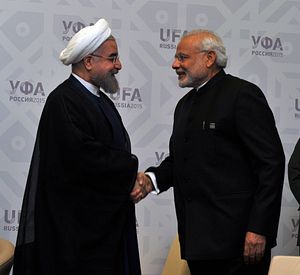New Delhi is certainly gearing up to seize the opportunities that the Iranian nuclear deal brings. What is equally critical at this stage is to preempt challenges to its regional strategy in a post-deal environment.
A new policy brief released by The Takshashila Institution provides some guidance on exactly that. The document titled “Mapping India’s response to Iran’s changing global status and regional influence” explores Iran’s possible futures and charts India’s approach in the four resulting scenarios. This exercise factors in changes in Iran’s international status and variations in its influence in the Middle East. The scenario most likely to emerge is one where Iran complies with the nuclear deal even as its influence flourishes in the Middle East.
One key takeaway here is that Iran will continue to evolve on both fronts – be it the extent of global integration or fluctuations in its regional influence. In response, New Delhi should be ready to push and protect its agenda.
In the last decade, Iran’s pariah status and isolation from the global economy reduced most bilateral discussions with India to more talk than action. Iran matters to India not only for cheaper energy but, increasingly, as a strategic partner in Afghanistan given the shared goal of limiting the Taliban’s role after the Americans exit. Iran is also key to fulfilling recent promises Prime Minister Modi made abroad, particularly to the five Central Asian nations, since it provides the necessary land access to connect New Delhi to these markets.
As has been widely noted, a nuclear deal or not, projects such as the Chabahar port and the railroads connecting it lie at the heart of New Delhi’s ambitions in its immediate neighborhood. Modi pushed ahead with the hugely delayed memorandum of understanding (MoU) with Iran before the final nuclear agreement was reached.
Now that we have a deal, one significant geopolitical impact is the exacerbation of tensions between long-time U.S. ally Saudi Arabia and Iran. It is now feared that the pro-Sunni Gulf Cooperation Council (GCC) states will work to further destabilize the region by amping up support to sectarian elements.
India’s strategy to step up engagement in Iran needs to factor in the effects of such fallout.
In the short-term, New Delhi needs to anticipate the risks associated with the development of the Chabahar port in south-east Iran, which lies in close proximity to Pakistan (about 50 km from border), in an environment of rising Iranian-Saudi acrimony. Its $85 million investment in the port through a joint venture between the Kandla Port Trust (KPT) and the Jawaharlal Nehru Port Trust (JNPT) will mean placing Indian assets (workers, equipment, etc.) on the ground in Iran.
In the last two years, Jaish-ul Adl, a pro-Sunni terrorist group targeting the Shiite Iranian regime, has stepped up attacks against Iranian security forces from its safe haven in Pakistan. The Iranians have accused the Saudis (and the Pakistanis on a lesser scale) of supporting the Jaish-ul Adl. The predecessor of this group, the Jundullah, even staged a suicide bombing in Chabahar killing 40 people in 2010. Given this past, New Delhi cannot afford to be unwittingly caught in the crossfire (if and) when things heat up.
A medium-to-long-term consideration for the Modi government is this – India needs to shore up partnerships with countries that practice moderation in the Middle East. Oman’s pragmatic foreign policy makes it a great candidate. The sultanate’s persistence in mediating a truce between Iran and the United States on the nuclear crisis paid off this year. Oman has also stayed neutral in the Yemen conflict proving to be a rare voice of moderation in the Middle East.
The good news is that India-Oman relations are on the right track. Being “natural allies” in the Indian Ocean region, bilateral ties were elevated to a strategic partnership in 2008. More recently, the Omani foreign minister made two visits in 2014. His second visit, in June last year, made him the first foreign (non-SAARC) dignitary to meet Modi after the elections. This year, Oman earned the distinction of being the first Middle Eastern country with which India holds exercises across all three defense services biennially.
On multilateral interactions, there are now strong indications that India will join the Ashgabat Agreement (between Oman, Iran, Turkmenistan and Uzbekistan) that aims to establish a transit corridor connecting Central Asia to the Persian Gulf. Such a venture would cement both India-Oman relations and an emerging India-Iran-Oman trilateral.
Delivering the 21st IISS Fullerton Lecture in Singapore in July, Indian Foreign Secretary S. Jaishankar emphasized that India “wants normalization in the region” and welcomed Iran’s “return to… commerce and business.” More interestingly, he framed India’s “immediate neighborhood” from Myanmar in the east to Iran in the west.
Iran’s return to the fold hopefully resuscitates the twelve-year-old “New Delhi Declaration” that established this vital strategic partnership. This time around, it is imperative that India keep a much closer watch on geopolitical shifts in the region.
Sumitha Narayanan Kutty is Associate Research Fellow at the S. Rajaratnam School of International Studies, Singapore. She was previously Scholar at The Takshashila Institution, India.
































